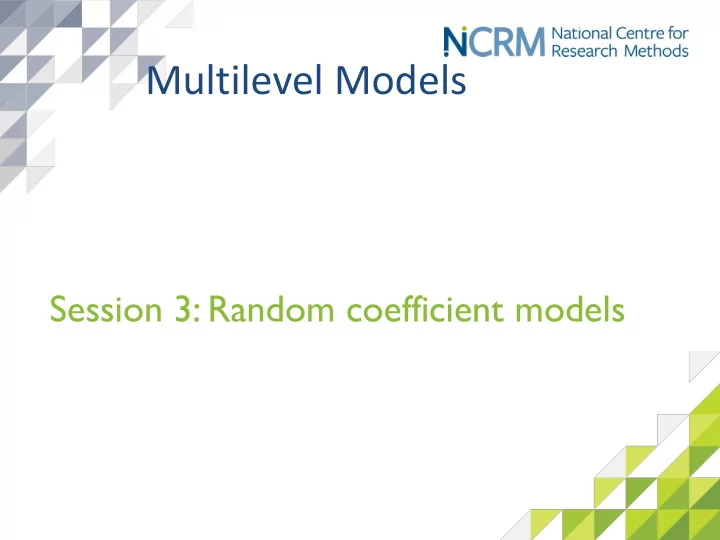

Multilevel Models Session 3: Random coefficient models
Outline • Random coefficient models – Allowing individual-level relationships to vary across groups – Linking individual and group level explanations – cross level interactions
Random intercept model of weight on height ˆ ˆ + x ˆ 0 1 i 1 = + + + y x u e ˆ 0 1 ij ij j ij ˆ 1 1 ˆ 2 ~ ( 0 , ) u u N 1 j u 2 ~ ( 0 , ) e N ˆ u ij e 2 • Previously we allowed average family height to be different in each family • But assumed relationship with weight constant • What if a unit increase in weight leads to different increases in height 3
Random coefficient model of weight on height ˆ ˆ + x 0 1 i ˆ u 11 = + + + + y x u u x e ij 0 1 ij 0 j 1 j ij ij ˆ 1 ˆ u ˆ u 12 01 ˆ u 02 • is average relationship between weight and height 1 1 + • Slope of group j is u 1 j 4
Random coefficient model of weight on height ˆ ˆ + x 0 1 i ˆ u 11 = + + + + y x u u x e ij 0 1 ij 0 j 1 j ij ij ˆ 1 u 2 ( ) 0 j = ˆ u 0 u ˆ ~ 0 , : N u 12 01 u u 2 u 1 j 01 1 u u ˆ u 02 • Deviations from average intercept and coefficient assumed 2 2 bivariate normal with variances u 0 u 1 • AND we also have information on how the residuals covary 01 u 5
(+)ve (-)ve covariance covariance Y = 2 + .5x Higher than average intercept = Higher Higher than average intercept = Lower (steeper) than average slope (flatter) than average slope Y = 2 - .5x Higher than average intercept = Higher Higher than average intercept = Lower (flatter) than average slope (steeper) than average slope 6
(+)ve (-)ve covariance covariance Y = 2 + .5x Higher than average intercept = Higher Higher than average intercept = Lower (steeper) than average slope (flatter) than average slope Y = 2 - .5x Higher than average intercept = Higher Higher than average intercept = Lower (flatter) than average slope (steeper) than average slope 7
(+)ve (-)ve covariance covariance Y = 2 + .5x Higher than average intercept = Higher Higher than average intercept = Lower (steeper) than average slope (flatter) than average slope Y = 2 - .5x Higher than average intercept = Higher Higher than average intercept = Lower (flatter) than average slope (steeper) than average slope 8
(+)ve (-)ve covariance covariance Y = 2 + .5x Higher than average intercept = Higher Higher than average intercept = Lower (steeper) than average slope (flatter) than average slope Y = 2 - .5x Higher than average intercept = Higher Higher than average intercept = Lower (flatter) than average slope (steeper) than average slope 9
Example: Fear of Crime across neighbourhoods RANDOM COEFFICIENT MODEL Crime Survey for England and Wales, 2013/14 MODEL 1 MODEL 2 MODEL 3 FIXED PART Intercept 0.027 (.009) -.007 (.009) -.007 (.009) x 1 ij Age (in years) -.004 (.001) -.004 (.001) x 2 ij Victim in last 12 months .262 (.014) .264 (.015) x 3 j Crime Rate .233 (.012) .233 (.012) RANDOM PART 2 Individual variance 0.863 (.008) .855 (.008) .853 (.008) e s u 0 2 Neighbourhood variance 0.145 (.007) .104 (.006) .097 (.007) s u 2 2 Victim variance .048 (.014) s u 02 Covariance -.022 (.008) • Neighbourhood variance = how levels of fear vary across neighbourhoods for non-victims (e.g. when victim=0). • Victim variance quantifies variation across neighbourhoods in the effect of being a victim
Graphical representation of random coefficient and covariance term
Cross level interactions • Allow the effect of an explanatory variable on y to depends on the value of another (grouping) variable • Do people experience context differently? • Place individuals directly within their context = + + + + + + y x x x x u u x e ij 0 1 ij 2 j 3 1 ij 2 j j 1 j ij ij • Often included when individual level variables has a random coefficient 12
Example: Fear of Crime across neighbourhoods CROSS LEVEL INTERACTION MODEL Crime Survey for England and Wales, 2013/14 MODEL 1 MODEL 2 MODEL 3 MODEL 4 FIXED PART Intercept 0.027 (.009) -.007 (.009) -.007 (.009) -.011 (.009) x 1 ij Age (in years) -.004 (.001) -.004 (.001) -.004 (.001) x 2 ij Victim in last 12 months .262 (.014) .264 (.015) .268 (.015) x 3 j Crime Rate .233 (.012) .233 (.012) .217 (.013) x 2 ij * x 3 j Victim * Crime Rate -.067 (.021) RANDOM PART 2 Individual variance 0.863 (.008) .855 (.008) .853 (.008) .853 (.008) e s u 0 2 Neighbourhood variance 0.145 (.007) .104 (.006) .097 (.007) .097 (.007) s u 2 2 Victim variance .048 (.014) .046 (.014) s u 02 Covariance -.022 (.008) -.020 (.008) • Non-victim: Fear = -.011 + .217 Crime Rate • Victim: Fear = (-.011+.268) + (.217-.067) Crime rate Fear = .257 + .150 Crime Rate
Summary • Random coefficient models can be used to more accurately account for differential associations between x and y across groups • Cross-level interactions connect individual and group level explanations • Extends readily to multiple random effects and additional levels • Models also available for non-normal data (e.g. binary, categorical, ordered categories, poisson)
Useful websites for further information • www.understandingsociety.ac.uk (a ‘biosocial’ resource) • www.closer.ac.uk (UK longitudinal studies) • www.ukdataservice.ac.uk (access data) • www.metadac.ac.uk (genetics data) • www.ncrm.ac.uk (training and information)
Recommend
More recommend